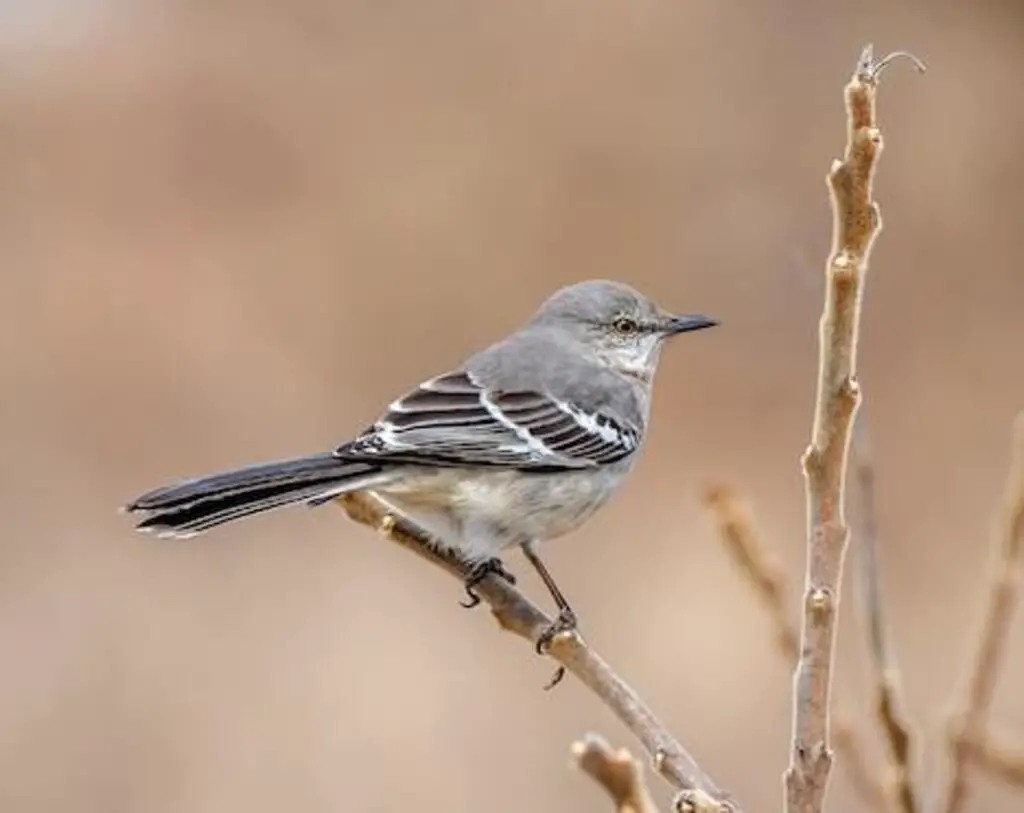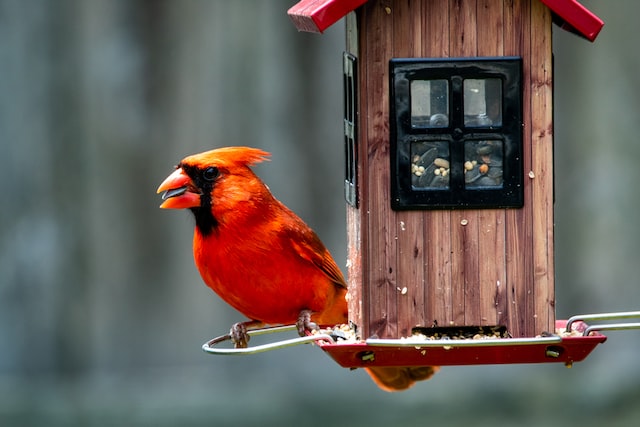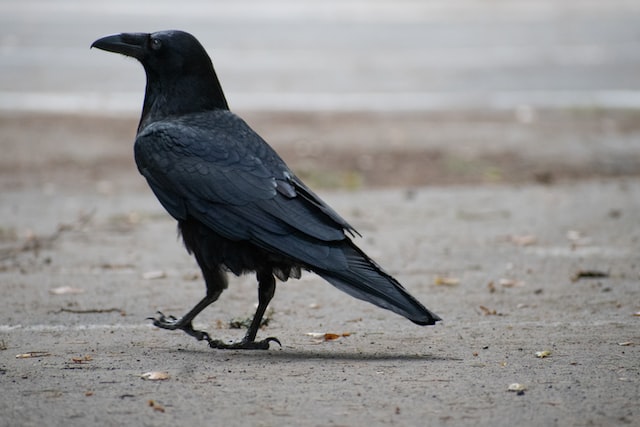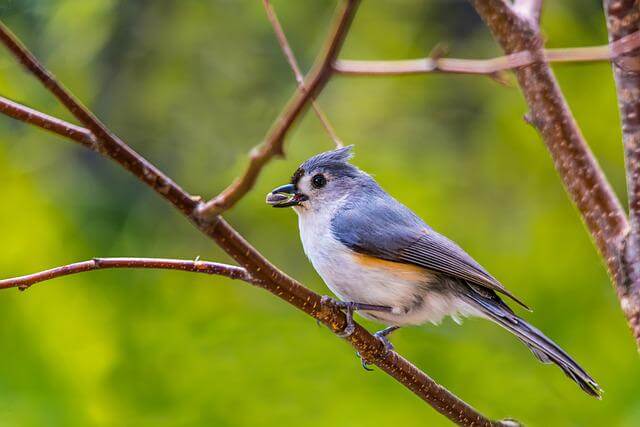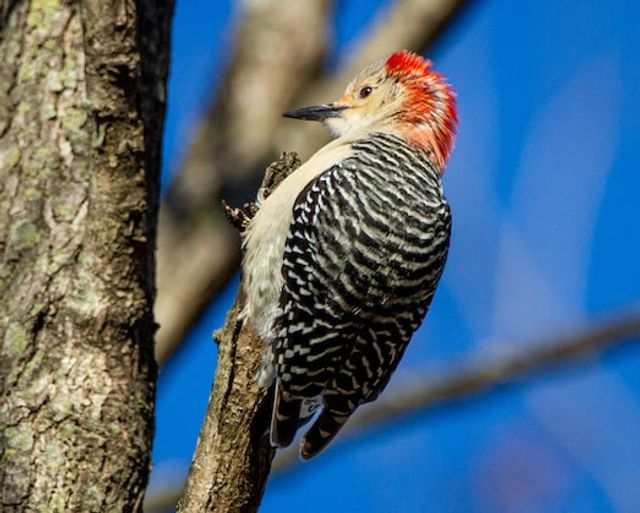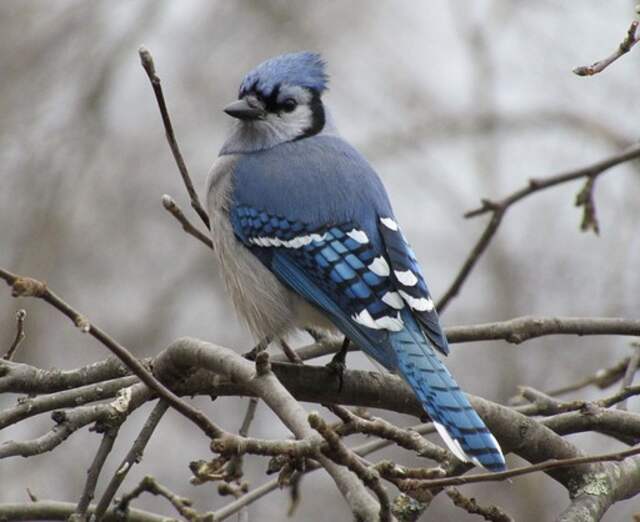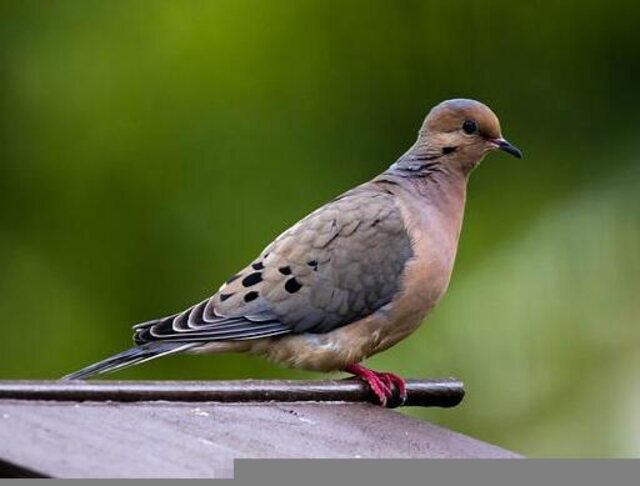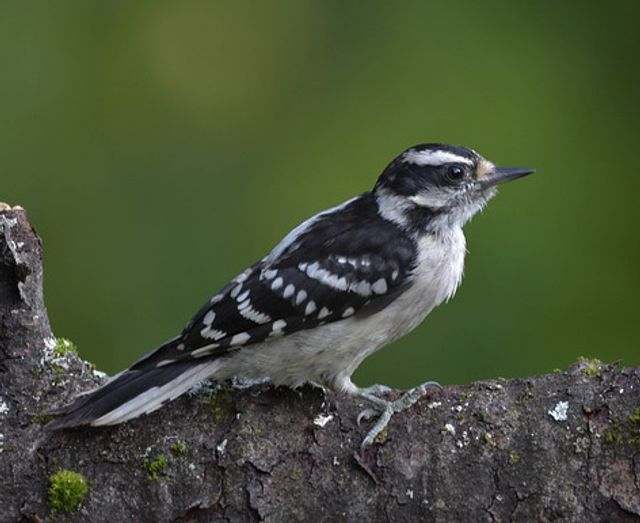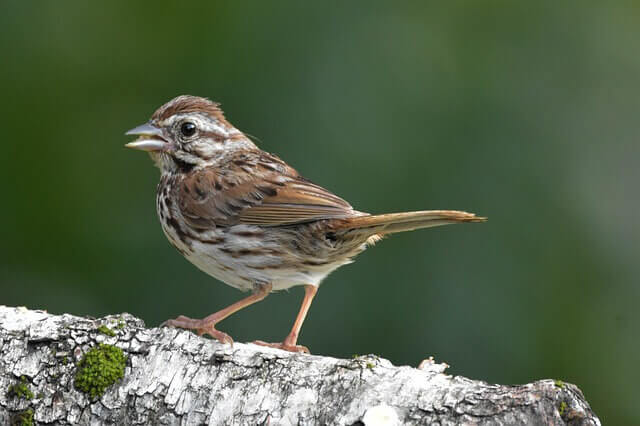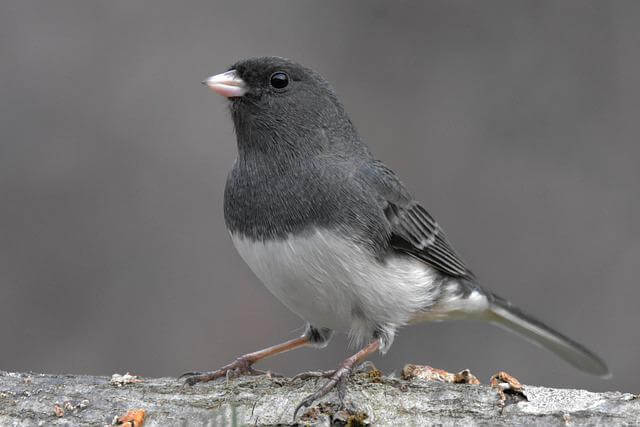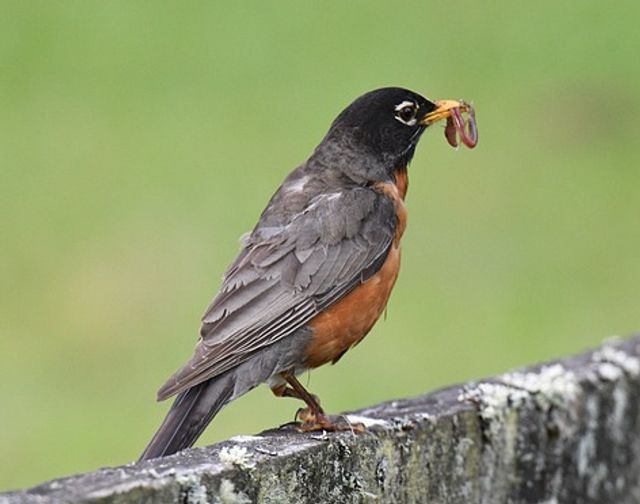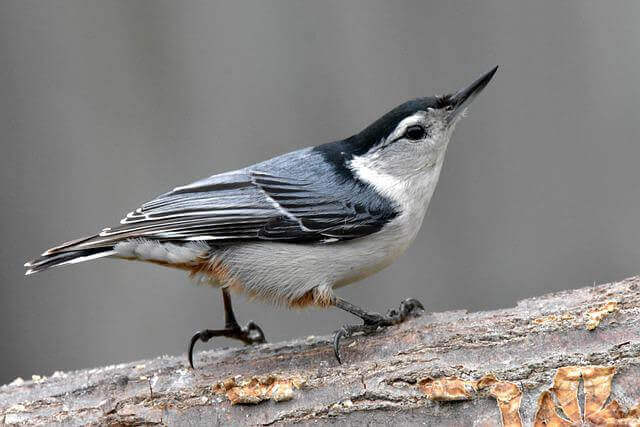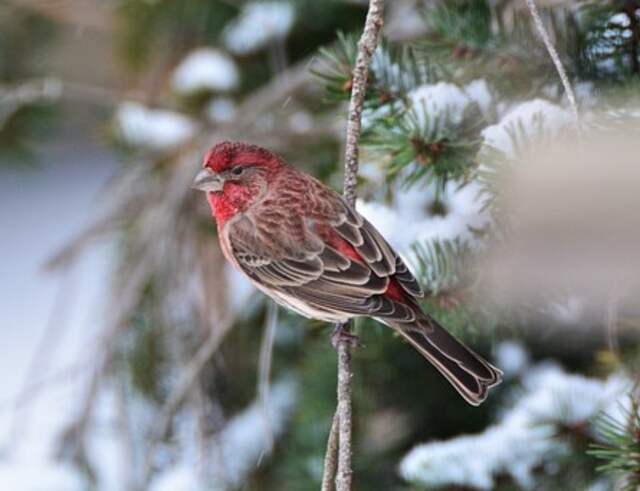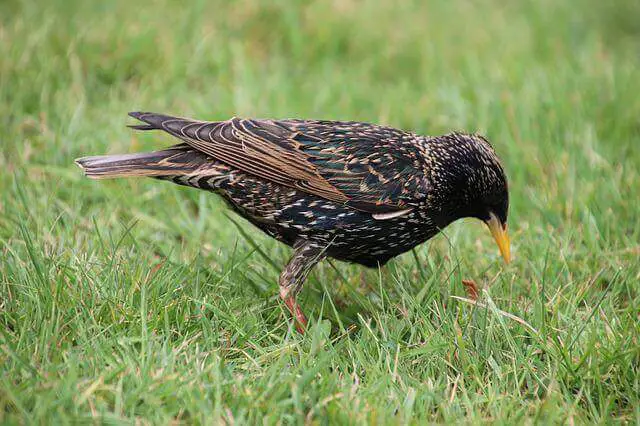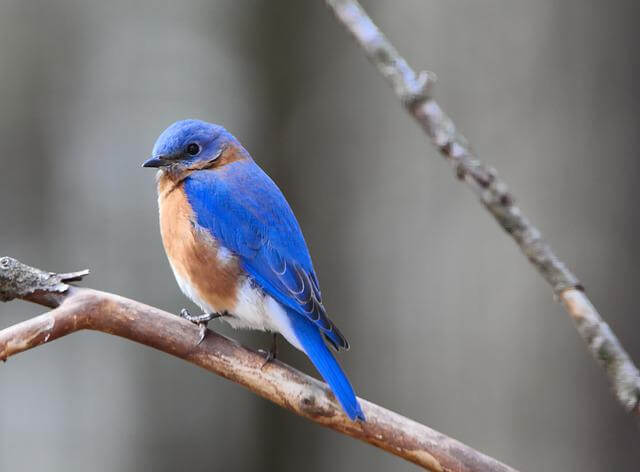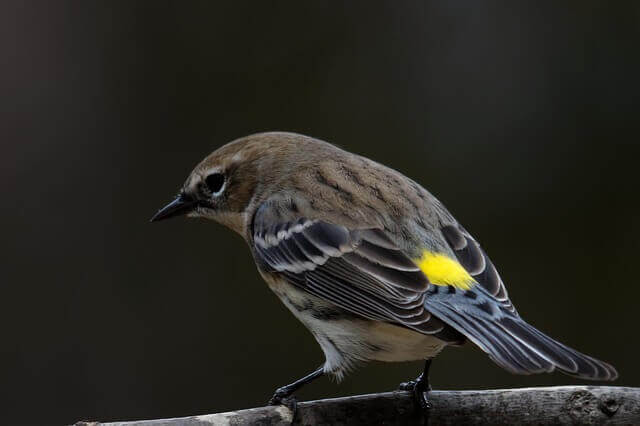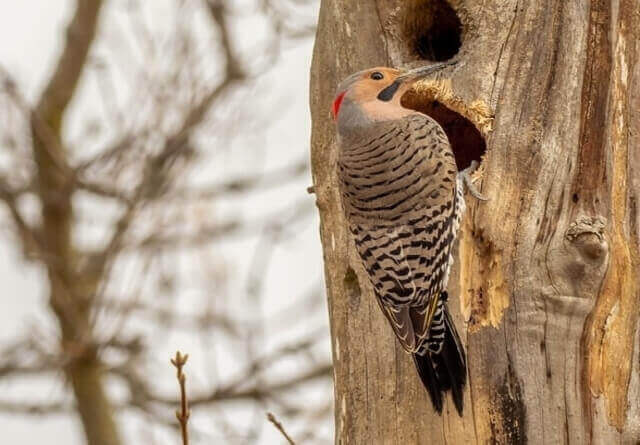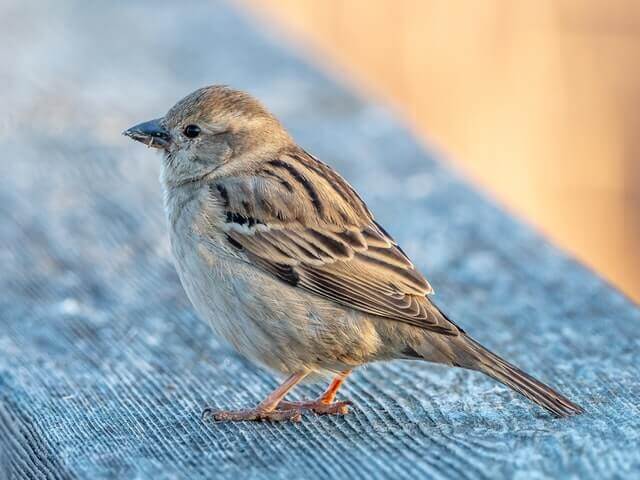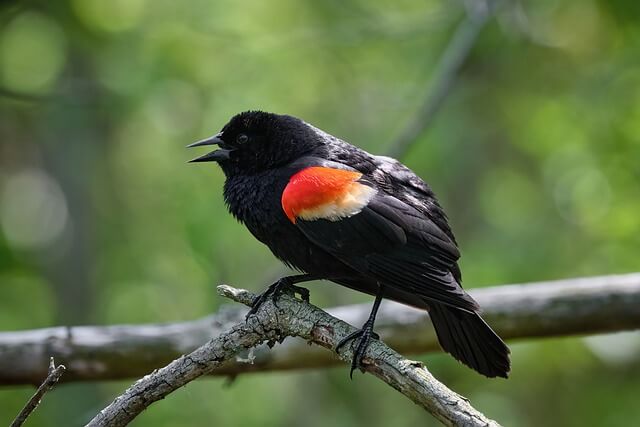Welcome to our expert guide on the 23 backyard winter birds in Virginia! From the cheerful Northern Cardinal to the elusive Eastern Bluebird, Virginia’s winter landscape is teeming with avian life. In this comprehensive guide, we’ll delve into each bird species’ unique characteristics, habits, and behaviors, offering valuable insights for birdwatchers and nature enthusiasts.
Table of Contents
- 1 Backyard Winter Birds in Virginia
- 1.1 Northern Cardinal
- 1.2 Carolina Wren
- 1.3 Carolina Chickadee
- 1.4 American Crow
- 1.5 White-throated Sparrow
- 1.6 Tufted Titmouse
- 1.7 Red-bellied Woodpecker
- 1.8 Blue Jay
- 1.9 Mourning Dove
- 1.10 Downy Woodpecker
- 1.11 Song Sparrow
- 1.12 Dark-eyed Junco
- 1.13 American Robin
- 1.14 White-breasted Nuthatch
- 1.15 House Finch
- 1.16 American Goldfinch
- 1.17 European Starling
- 1.18 Eastern Bluebird
- 1.19 Northern Mockingbird
- 1.20 Yellow-rumped Warbler
- 1.21 Northern Flicker
- 1.22 House Sparrow
- 1.23 Red-winged Blackbird
- 2 Author
Backyard Winter Birds in Virginia
Northern Cardinal
- Length: 8.3-9.1 in (21-23 cm)
- Weight: 1.5-1.7 oz. (42-48 g)
- Wingspan: 9.8-12.2 in (25-31 cm)
- Scientific Name: Cardinalis cardinalis
- Frequency of Occurrence: 55.62% (Statistic: eBird)
- Maps: Range Map – Sightings Map
- Sounds: Calls and Sounds
- Where To Find Them: During the winter months, Northern Cardinals can be found in a variety of locations throughout Virginia. While they are typically found in wooded areas, they can also be found in open fields and even near human habitation. Some of the best places to look for Northern Cardinals in Virginia are Shenandoah National Park, George Washington and Jefferson National Forests, and Mount Rogers National Recreation Area.
- How to Attract Them: They are relatively easy to attract to your yard with the right food and feeder. Cardinals prefer a platform feeder with Safflower seeds, black oil sunflower seeds, and white milo.
General Information: The Northern Cardinal is a common bird found throughout the eastern United States. They are easily recognizable by their red plumage and black mask. Cardinals are year-round residents in woodlands, gardens, and backyards. The diet of Northern Cardinals consists mainly of seeds, fruits, and insects. In the winter months, they will often eat berries and fruits to supplement their diet.
Cardinals are also known to eat snails, lizards, and small frogs. Northern Cardinals have a large range that extends from southern Canada to northern Mexico. They are most commonly found in woods or forest edges near thick vegetation. During the breeding season, Cardinals will also inhabit open areas with little vegetation, such as fields or prairies.
Related:
- 10 Best Bird Feeders for Cardinals (Rated for 2022)
- Best Birdhouse for Cardinals 2022 (Tested And Rated)
- Where Are Cardinals Found? Best Spots to Look!
Carolina Wren
- Length: 4.7-5.5 in (12-14 cm)
- Weight: 0.6-0.8 oz (18-22 g)
- Wingspan: 11.4 in (29 cm)
- Scientific Name: Thryothorus ludovicianus
- Frequency of Occurrence: 45.44%
- Maps: Range Map – Sightings Map
- Sounds: Calls and Sounds
- Where To Find Them: While they are commonly seen in Virginia during the summer months, they can also be found in the state during the winter. The locations that they are most often seen in Virginia during the winter months include Richmond, Norfolk, and Fairfax.
- How to Attract Them: If you want to attract a Carolina wren to your yard, try putting out a platform feeder with mealworms, sunflower seeds, or peanut pieces.
General Information: The Carolina Wren is a small songbird that ranges throughout the southeastern United States. They are common in woodlands, swamps, and gardens, and can even be found in urban areas. Their diet consists mostly of insects, but they will also eat berries and other small fruits. Carolina Wrens are non-migratory birds, which means they stay in their breeding range year-round.
The male and female will work together to build a nest out of twigs, leaves, and grasses. The female will lay 3-8 eggs in the nest, and both parents will help to incubate them. Carolina Wrens are one of the few bird species that actually seem to enjoy the company of humans.
Related: How to Attract Wrens to your Backyard? (Expert’s Guide)
Carolina Chickadee
- Length: 4.7-6.0″ in (12.0-15.2 cm)
- Weight: 0.3-0.5 oz (9-14 g)
- Wingspan: 6.3-8.3 in (16-21 cm)
- Scientific Name: Poecile carolinensis
- Frequency of Occurrence: 45.08%
- Where To Find Them: In Virginia, they can be found in woods and forests throughout the state, including both the Appalachian Mountains and the Blue Ridge Mountains. They are also common in suburban areas and parks.
- How to Attract Them: Carolina wrens are attracted to yards with plenty of cover. So, if you want to attract them to your yard, make sure to provide plenty of dense shrubs and evergreens. This will give them the shelter they need from the cold winter weather. In addition to providing shelter, you’ll also need to offer food sources that Carolina wrens find irresistible. Black-oil sunflower seeds, safflower, and peanut pieces are all great options. You can offer these foods in a tube feeder placed near dense shrubbery.
General Information: The Carolina Chickadee (Poecile carolinensis) is a small, black-and-white songbird that is a common sight in forests and backyards across the southeastern United States. This adaptable bird can be found in a variety of habitats, from the mountains to the coast, and its diet consists of insects, seeds, and berries.
The Carolina Chickadee has a black cap and bib, white cheeks, and a gray back and wings. The underparts are white with buffy flanks. Adult birds are 4.5 to 6.0 inches long, with a wingspan of 7 to 8 inches. Females and males look alike, but juveniles have duller plumage. This chickadee is an opportunistic feeder that will eat whatever food is available.
Related: Carolina Chickadees – 9 Best Ways To Attract Them Fast!
American Crow
- Length: 15.8-20.9 in (40-53 cm)
- Weight: 11.2-21.9 oz. (316-620 g)
- Wingspan: 33.5-39.4 in (85-100 cm)
- Scientific Name: Corvus brachyrhynchos
- Frequency of Occurrence: 43.83%
- Maps: Range Map – Sightings Map
- Sounds: Calls and Sounds
- Where To Find Them: In Virginia, you can find them in forests, fields, marshes, and even urban areas. While they are generally more common in rural areas, crows can also be seen in cities and towns during the winter months. One of the best places to see crows in Virginia during the winter is at Chincoteague National Wildlife Refuge.
- How to Attract Them: First, make sure you have a platform feeder that can accommodate corn, peanuts, or sunflower seeds. Crows are omnivorous, so they’ll be happy with any of these options. Second, keep your feeder clean and full. Crows are notoriously messy eaters, so you’ll want to make sure there’s always plenty of food available.
General Information: The American crow is a bird of the family Corvidae. This bird is found in North America, from Alaska and Canada to the Atlantic coast of the United States. The range of the American crow extends southward into Mexico and Central America. They can be found in forests, woodlands, farmland, urban areas, and even coastal marshes.
They seem to do best in open areas with some trees or other structures for perching and nesting. Their diet consists of a variety of items, including insects, small mammals, berries, and carrion. In the winter months, they will often eat acorns and other nuts. American Crows will also cache food items for later consumption.
Related: How To Attract Crows To Your Backyard: Expert Tips!
White-throated Sparrow
- Length: 6.3-7.1 in (16-18 cm)
- Weight: 0.8-1.1 oz. (22-32 g)
- Wingspan: 7.9-9.1 in (20-23 cm)
- Scientific Name: Zonotrichia albicollis
- Frequency of Occurrence: 41.82%
- Maps: Range Map – Sightings Map
- Sounds: Calls and Sounds
- Where To Find Them: The White-throated Sparrow is a type of bird that can be found in many different areas across Virginia. Here are three specific locations where you might be able to spot one this winter: Mount Rogers National Recreation Area – This spot is great for bird watching all year round, but you’ll have a good chance of seeing a White-throated Sparrow if you go during the winter months. There are also plenty of other birds and wildlife to see in this beautiful recreation area. Chincoteague National Wildlife Refuge – This refuge is known for its large variety of birds, and the White-throated Sparrow is just one of many that you could see while visiting.
- How to Attract Them: If you’re hoping to spot a white-throated sparrow in your yard this winter, you’ll need to take some steps to attract them. One of the best ways to do this is by putting out a tube feeder filled with millet or sunflower seeds. Another way to attract these birds is by providing them with some cover. This can be in the form of evergreen trees or shrubs, which will give them a place to roost and hide from predators. Finally, make sure there’s plenty of fresh water available, as white-throated sparrows love to bathe.
General Information: The White-throated Sparrow (Zonotrichia albicollis) is a small songbird that breeds in North America. This sparrow is typically found in open woodlands, brushy areas, and forest edges. The White-throated Sparrow has a wide range, spanning from Alaska to Nova Scotia and south to California and North Carolina.
The White-throated Sparrow is a mostly seed eating bird but will also eat insects. In the winter months, when seeds are scarce, this sparrow will switch to an all-insect diet. The White-throated Sparrow forages on the ground, scratching at the leaf litter with its bill to find food. This sparrow usually nests in trees or shrubs, building a cup nest out of twigs, grasses, and leaves.
Tufted Titmouse
- Length: 5.5-6.3 in (14-16 cm)
- Weight: 0.6-0.9 oz. (18-26 g)
- Wingspan: 7.9-10.2 in (20-26 cm)
- Scientific Name: Baeolophus bicolor
- Frequency of Occurrence: 39.84%
- Maps: Range Map – Sightings Map
- Sounds: Calls and Sounds
- Where To Find Them: Although the Tufted Titmouse is a common bird found throughout most of Virginia, there are certain locations and areas where they are more likely to be spotted in winter. One such place is Shenandoah National Park, where titmice can often be seen foraging for food among the trees. Another good spot for seeing these birds is George Washington and Jefferson National Forests; here, visitors can look for them near streams or other water sources. Finally, the Great Dismal Swamp National Wildlife Refuge is another excellent place to see Tufted Titmice in winter; the refuge’s many ponds and marshes provide ideal habitat for these birds.
- How to Attract Them: If you want to attract tufted titmice to your yard, you should put out a tube feeder with black oil sunflower seeds or hulled sunflower kernels.
General Information: The Tufted Titmouse (Baeolophus bicolor) is a small songbird that ranges throughout the eastern United States. These birds are easily identified by their bluish-gray body, tufted head feathers, black forehead and white cheeks. The bird is a common bird found in woodlands, forests, and backyards. The range also extends from Maine to Florida and west to Texas. They are year-round residents in their distribution range.
The Tufted Titmouse is a non-migratory bird. The habitat of the Tufted Titmouse includes woodlands, forests, and suburban areas. These birds are often found near houses and will readily come to feeders. The Tufted Titmouse prefers deciduous trees, but can also be found in mixed forests and coniferous woods. The diet of the Tufted Titmouse consists of insects, seeds, and berries.
Related: How to Attract Tufted Titmouse to my Yard? (Explained)
Red-bellied Woodpecker
- Length: 9.4 in (24 cm)
- Weight: 2.0-3.2 oz. (56-91 g)
- Wingspan: 13.0-16.5 in (33-42 cm)
- Scientific Name: Melanerpes carolinus
- Frequency of Occurrence: 37.80%
- Maps: Range Map – Sightings Map
- Sounds: Calls and Sounds
- Where To Find Them: They have been spotted in Virginia during the winter months. Some of the areas where they have been seen include Shenandoah National Park, George Washington and Jefferson National Forests, and Charlottesville.
- How to Attract Them: First, set out a tube feeder filled with peanuts, sunflower seeds. Secondly, hang a suet feeder in an area where the woodpeckers are likely to see it and be attracted to it. Finally, provide a source of water for the birds to drink and bathe in. By following these simple tips, you’ll be sure to enjoy the company of these beautiful birds all winter long!
General Information: The Red-bellied Woodpecker is found throughout the eastern United States, from Maine to Florida and west to Texas and the Great Plains. It is a year-round resident in most of its range, although some northern birds may migrate south in winter. This woodpecker inhabits both deciduous and coniferous forests, as well as urban parks and suburban yards.
It often nests in cavities excavated by other woodpeckers, but will also use man-made nesting boxes. The Red-bellied Woodpecker feeds on insects, acorns, berries, and other small fruits. It often hammers on tree trunks to find insects hidden beneath the bark. This bird gets its name from the red patch of feathers on its belly, which is usually more visible on males than females.
Related: How to Attract Red-bellied Woodpeckers to your Yard?
Blue Jay
- Length: 9.8-11.8 in (25-30 cm)
- Weight: 2.5-3.5 oz. (70-100 g)
- Wingspan: 13.4-16.9 in (34-43 cm)
- Scientific Name: Cyanocitta cristata
- Frequency of Occurrence: 37.50%
- Maps: Range Map – Sightings Map
- Sounds: Calls and Sounds
- Where To Find Them: Blue Jays are found in forests, woodlands, and backyards. In Virginia, they can be seen in the Shenandoah Valley, Blue Ridge Mountains, and near Virginia Beach.
- How to Attract Them: If you’re looking to attract blue jays to your yard this winter, there are a few things you can do. First, make sure you have a tube feeder stocked with mealworms, sunflower seeds, and cracked corn.
General Information: The Blue Jay is a striking bird with a blue body and crest, white underparts and a black necklace. The Blue Jay has a large range, stretching from southern Canada to northern Mexico. In the east of its range, it is found in deciduous forests while in the west; it is found in coniferous forests.
Blue Jays prefer areas with dense trees and understory, but can also be found in open woodlands and suburbs. The diet of the Blue Jay consists mostly of acorns, nuts and seeds. In the fall and winter months, when these foods are scarce, they will also eat fruits such as berries and insects. Small birds have often been part of their diet as well.
Related:
- 15 Best Bird Feeders For Blue Jays (Tried & Tested 2022)
- What Attracts Blue Jays to your Yard?(Expert Tips)
- What Does A Blue Jay Eat? (10 Favorite Foods Revealed!)
Mourning Dove
- Length: 9.1-13.4 in (23-34 cm)
- Weight: 3.4-6.0 oz. (96-170 g)
- Wingspan: 17.7 in (45 cm)
- Scientific Name: Zenaida macroura
- Frequency of Occurrence: 36.96%
- Maps: Range Map – Sightings Map
- Sounds: Calls and Sounds
- Where To Find Them: The Great Dismal Swamp National Wildlife Refuge is one of the largest protected areas of habitat for Mourning Doves in Virginia. The refuge spans over 113,000 acres and is home to a variety of wildlife
- How to Attract Them: One of the best ways to attract Mourning Doves to your yard is by putting out a platform feeder filled with sunflower seeds, cracked corn, and shelled peanuts. Another tip is to make sure there are plenty of trees or shrubs nearby for the birds to perch in while they eat. And last but not least, don’t forget to keep your birdbath clean and filled with fresh water
General Information: Mourning Doves are found in North America, Central America, and the Caribbean. Their range extends from Canada to Panama. Mourning Doves prefer open habitats such as prairies, farmland, and desert edges. They also occur in woodlands, forests, and towns. Mourning Doves eat mostly seeds. They forage on the ground or among shrubs. In winter, they consume more crop grains.
They also eat some insects, especially in spring, when the adults are feeding their young. Mourning Doves nest in trees or shrubs. The female builds the nest out of twigs and grasses, and typically lays two eggs in the nest. The young hatch after about two weeks.
Related:
- Best Bird Feeder For Doves (Reviewed & Tested for 2022)
- Facts About Mourning Doves – 10 Things You Need To Know!
Downy Woodpecker
- Length: 5.5-6.7 in (14-17 cm)
- Weight: 0.7-1.0 oz. (21-28 g)
- Wingspan: 9.8-11.8 in (25-30 cm)
- Scientific Name: Picoides pubescens
- Frequency of Occurrence: 35.64%
- Maps: Range Map – Sightings Map
- Sounds: Calls and Sounds
- Where To Find Them: Some good places to look for Downy Woodpeckers include Shenandoah National Park, George Washington and Jefferson National Forests, and any other large tracts of forestland.
- How to Attract Them: In winter, they are attracted to platform feeders with mealworms or tube feeders with black oil sunflower seeds, millet, and peanuts.
General Information: The Downy Woodpecker is a small woodpecker that is found in forests throughout North and Central America. They are known as the tiniest type of woodpecker in North America. The adult Downy Woodpecker is about 6-7 inches in length with a wingspan of 9-10 inches. The adult Downy Woodpecker has a black back, white belly, and a black and white head.
The male Downy Woodpecker has a distinctive red patch on the back of its head. The Downy Woodpecker ranges from Alaska and Canada to Guatemala. The Downy Woodpecker prefers mature forests with lots of trees for nesting and foraging. The Downy Woodpecker will also use suburban areas and parks. The diet of the Downy Woodpecker consists of insects, spiders, berries, and fruits.
Related:
- How to Attract Downy Woodpeckers to Your Yard? (Easy!)
- 7 Birds That Look Like Downy Woodpecker (Explained)
Song Sparrow
- Length:4.7-6.7 in (12-17 cm)
- Weight: 0.4-1.9 oz. (12-53 g)
- Wingspan: 7.1-9.4 in (18-24 cm)
- Scientific Name: Melospiza melodia
- Frequency of Occurrence: 35.07%
- Maps: Range Map – Sightings Map
- Sounds: Calls and Sounds
- Where To Find Them: The Song Sparrow is a bird that can be found in many different locations throughout Virginia. Some of the best places to see them are in the Shenandoah National Park, George Washington and Jefferson National Forests, and Richmond. They can also be found in other smaller parks and forests throughout the state.
- How to Attract Them: The Song Sparrow is a very versatile eater and will consume a wide variety of food items. They are particularly fond of sunflower seeds, but will also eat safflower seed, white proso millet, thistle seeds or cracked corn.If you provide these food items in a tube feeder, the Song Sparrow will quickly find their way to your yard and provide you with endless hours of enjoyment.
General Information: The song sparrow (Melospiza melodia) is a small bird found throughout North America. The bird gets its name from the male’s song, which is a clear and musical trill. The song sparrow is a brown and gray bird with streaked feathers and a long tail. The bird ranges in size from 5 to 6 inches in length and has a wingspan of 7 to 8 inches.
The song sparrow is found in a variety of habitats including forests, fields, and wetlands. The bird typically nests in trees or shrubs, but will also nest on the ground if necessary. The song sparrow’s diet consists mostly of insects and seeds. In the winter months, the bird may eat berries or other fruits.
Related:
- How to Attract Sparrows to your Backyard? (Like A Pro)
- Birds That Look Like Sparrows: 16 Most Common Types!
Dark-eyed Junco
- Length: 5.5-6.3 in (14-16 cm)
- Weight: 0.6-1.1 oz. (18-30 g)
- Wingspan: 7.1-9.8 in (18-25 cm)
- Scientific Name: Junco hyemalis
- Frequency of Occurrence: 34.96%
- Maps: Range Map – Sightings Map
- Sounds: Calls and Sounds
- Where To Find Them: In the winter, they can be found in woodlands, parks, and gardens south of their breeding range. In Virginia, they are most commonly seen in the Shenandoah Valley and Appalachian Mountains.
- How to Attract Them: The Dark-eyed Junco is a beautiful little bird that can be found in many yards during the winter months. They are attracted to tube feeders filled with hulled sunflower seed, white proso millet, and cracked corn. By providing these foods, you will be sure to bring these lovely birds to your yard!
General Information: The Dark-eyed junco (Junco hyemalis) is a member of the sparrow family. These birds are small, with gray upperparts and white underparts. The sides of their heads and necks are black, and they have a white stripe above their eyes. Their tails are usually darker than their backs. Dark-eyed juncos are found in North America from Alaska to Newfoundland, south to California and Arizona.
They prefer open woodlands, but can also be found in mountains, tundra, and even urban areas. In winter, they migrate to lower altitudes. These birds mostly eat seeds, but will also eat insects in the summer. To find food, they forage on the ground or in low bushes. You may see them scratching the ground with their feet to uncover food.
Related: Fun Facts About Dark-eyed Juncos
American Robin
- Length: 7.9-11.0 in (20-28 cm)
- Weight: 2.7-3.0 oz (77-85 g)
- Wingspan: 12.2-15.8 in (31-40 cm)
- Scientific Name: Turdus migratorius
- Frequency of Occurrence: 29.42%
- Maps: Range Map – Sightings Map
- Sounds: Calls and Sounds
- Where To Find Them: One of the best places to see American Robins in Virginia is Shenandoah National Park. This park offers ample opportunities to view these birds in their natural habitat as they forage for food and build nests. Another great location is the George Washington and Jefferson National Forests. These forests provide perfect habitat for American Robins, and visitors can often spot them near campgrounds and picnic areas.
- How to Attract Them: First, put up a platform feeder with mealworms. This is one of their favorite foods and it will give them a reason to visit your yard. Second, keep your yard clean and clutter-free. Robins prefer to nest and roost in areas that are neat and tidy. Third, provide some cover from the elements. A few shrubs or evergreens placed near the feeder will give the robins a place to escape the wind and snow.
General Information: The American Robin (Turdus migratorius) is a migratory songbird of the true thrush genus and Turdidae, the wider thrush family. American robins are widely distributed across North America, wintering in the southern regions of Canada to central Mexico and along the Pacific Coast. It is a common bird found in open areas including deciduous or mixed woodlands and urban parks and gardens, but generally avoids dense forests.
Diet consists mostly of insects during the breeding season, which shifts to fruits during migration and in winter. Some important food items include earthworms, beetles, caterpillars, flies and other small invertebrates. Fruits consumed include blueberries, cherries and grape jelly.
Related:
- How To Attract Robins To Your Yard – 7 Best Tips!
- 5 Best Bird Feeders For Robins (Tested & Rated For 2022)
White-breasted Nuthatch
- Length: 5.1-5.5 in (13-14 cm)
- Weight: 0.6-1.1 oz. (18-30 g)
- Wingspan: 7.9-10.6 in (20-27 cm)
- Scientific Name: Sitta carolinensis
- Frequency of Occurrence: 29.38%
- Maps: Range Map – Sightings Map
- Sounds: Calls and Sounds
- Where To Find Them: In Virginia, it can be seen in the Blue Ridge Mountains, Shenandoah National Park, and George Washington and Jefferson National Forests.
- How to Attract Them: In order to attract a White-breasted Nuthatch to your yard this winter, you will need to set up a platform feeder with mealworms. This little bird is attracted to areas with trees and dense vegetation, so your yard should provide plenty of places for them to hide and build their nests. They are not shy birds, so you may even be able to entice them into your home!
General Information: The White-breasted Nuthatch is a small songbird with a large head and a long, pointed bill. They are blue gray above and white below, with a black cap and white “eyebrow”. They are found in forests and woodland areas throughout North America. White-breasted Nuthatches breed in deciduous and mixed forests. They nest in tree cavities, either excavating their own nest hole or using an existing one.
The female lays 4-8 eggs, which are incubated for 12-13 days before hatching. the White-breasted nuthatch’s diet consists mainly of insects and plant seeds. In the winter months, they will also eat berries and nuts. They forage for food on tree trunks and branches, using their strong toes to cling upside down if necessary!
Related: How to Attract Nuthatches to your Backyard? Expert Tips!
House Finch
- Length: 5.1-5.5 in (13-14 cm)
- Weight: 0.6-0.9 oz. (16-27 g)
- Wingspan: 7.9-9.8 in (20-25 cm)
- Scientific Name: Haemorhous mexicanus
- Frequency of Occurrence: 27.61%
- Maps: Range Map – Sightings Map
- Sounds: Calls and Sounds
- Where To Find Them: In Virginia, house finches can be seen in most counties throughout the state. They are particularly common in the Shenandoah Valley and around the cities of Richmond and Norfolk.
- How to Attract Them: Offer a variety of seeds in your bird feeder. House finches are especially fond of black oil sunflower seeds, striped sunflower seeds, millet, and milo.Keep your bird feeder clean and full. A well-maintained bird feeder will be more attractive to birds than one that is neglected. Place your bird feeder in an open area of your yard away from trees or other obstacles.
General Information: The House Finch (Carpodacus mexicanus) is a bird in the finch family. It is native to western North America, where it ranges from Alaska to Mexico. The House Finch is a common bird in urban and suburban areas in the eastern United States. The House Finch is a small bird, measuring a bit over five inches in length. The male House Finch has red feathers on its head, back, and breast.
The female House Finch is brown or gray with streaks on her breast. The House Finch prefers open woodlands, gardens, and scrublands. In winter, the House Finch may be found in fields and along roadsides. The diet of the House Finch consists of seeds, berries, and insects.
Related:
- How to Attract House Finch to your Yard? (Easy & Fast)
- 9 Best Birdhouse for Finches? (Rated & Tested for 2022)
American Goldfinch
- Length: 4.3-5.1 in (11-13 cm)
- Weight: 0.4-0.7 oz. (11-20 g)
- Wingspan: 7.5-8.7 in (19-22 cm)
- Scientific Name: Spinus tristis
- Frequency of Occurrence: 27.54%
- Maps: Range Map – Sightings Map
- Sounds: Calls and Sounds
- Where To Find Them: The American Goldfinch is a beautiful bird that can be seen in many different locations in Virginia. Some of the best places to see them are in the Shenandoah Valley, at Sky Meadows State Park, and in the Blue Ridge Mountains.
- How to Attract Them: . In winter, these birds are attracted to tube feeders filled with black oil sunflower seeds, thistle, millet, and milo. If you’re looking to attract American Goldfinches to your yard this winter, follow these simple tips and you’ll be sure to have a few of these pretty birds visiting in no time!
General Information: The American Goldfinch is a small, sprightly bird with a cheerful song. It is a common sight at backyard bird feeders across North America. These finches are most often found in open woodlands and weedy fields. They nest in trees and shrubs, often near the ground. The American Goldfinch has a yellow body with black wings and tail. The male has a black cap on its head during the breeding season.
These birds are about 4-5 inches long and have a wingspan of about 7-8 inches. American Goldfinches eat mostly seeds, including thistle seeds, sunflower seeds, and millet. They will also eat insects, especially during the nesting season when they need to provide food for their young chicks.
Related:
- Interesting American Goldfinch Facts You Need to Know!
- 9 Birds That Look Like Goldfinches (Explained)
European Starling
- Length: 7.9-9.1 in (20-23 cm)
- Weight: 2.1-3.4 oz. (60-96 g)
- Wingspan: 12.2-15.8 in (31-40 cm)
- Frequency of Occurrence: 26.92%
- Scientific Name: Sturnus vulgaris
- Maps: Range Map – Sightings Map
- Sounds: Calls and Sounds
- Where To Find Them: One place to see European Starlings is at the Rust Nature Sanctuary in Leesburg. This sanctuary is home to a large number of bird species, including the European Starling. Another place to see these birds is at Sky Meadows State Park. This park is located in the foothills of the Blue Ridge Mountains and offers miles of hiking trails and scenic views.
- How to Attract Them: In the winter months, these birds are typically found in woodlands and forests, but will also visit gardens and yards in search of food. Mealworms are a favorite food of European Starlings, so offering them up in a platform feeder is sure to attract some feathered visitors.
General Information: The European Starling is a small to medium-sized passerine bird in the family Sturnidae. The adult has black feathers with a metallic sheen and is about 20 cm in length. The wingspan is about 35 cm. The bill is yellow and the legs are black. The plumage of the juvenile is browner than that of the adult. The European Starling occurs naturally in Europe, Asia and Africa. It has been introduced to North America, Australia and New Zealand.
In North America, it is now one of the most common birds in urban areas. The range of the European Starling extends from Iceland and Scandinavia to northern Russia and Southern Africa. The habitat of the European Starling is varied. It occurs in open habitats such as farmland, grassland, parks and gardens.
Related: How To Attract European Starlings To Your Yard Fast?
Eastern Bluebird
- Length: 6.3-8.3 in (16-21 cm)
- Weight: 1.0-1.1 oz. (28-32 g)
- Wingspan: 9.7-12.5″in. (25-32 cm)
- Scientific Name: Sialia sialis
- Frequency of Occurrence: 26.77%
- Maps: Range Map – Sightings Map
- Sounds: Calls and Sounds
- Where To Find Them: A great place to see Eastern Bluebirds is Chincoteague National Wildlife Refuge. This refuge is located on Virginia’s Eastern Shore and is known for its abundance of bird life. In addition to the bluebirds, you’ll also find ospreys, eagles, and more at this stunning location.
- How to Attract Them: Put up a platform feeder and fill it with mealworms or sunflower hearts. Eastern Bluebirds love both of these foods. Make sure the feeder is in a sunny spot – Eastern Bluebirds prefer warm locations. Keep the feeder clean – scoop out any old food or waste regularly.
General Information: The Eastern Bluebird is a small thrush found east of the Rockies in North America. The adult male has blue upperparts and a rusty breast. The adult female is grayish blue with a paler throat and breast. Both sexes have white belly and undertail feathers, and orange legs. The Eastern Bluebird typically nests in trees, often near the edge of forests. It will also use nest boxes provided by humans.
Its diet consists mostly of insects, although it will also eat berries. The Eastern Bluebird has a large range, extending from southern Canada to the Gulf Coast of the United States. It is found in habitats ranging from open fields to forest edges, as long as there are trees nearby for nesting.
Related:
- 68 Fun Facts About Eastern Bluebirds (You Didn’t Know!)
- How to Attract Eastern Bluebirds to your Yard (Explained)
- 9 Best Birdhouses for Bluebirds (Top Picks for 2022)
Northern Mockingbird
- Length:8.3-10.2 in (21-26 cm)
- Weight: 1.6-2.0 oz (45-58 g)
- Wingspan: 12.2-13.8 in (31-35 cm)
- Scientific Name: Mimus polyglottos
- Frequency of Occurrence: 23.84%
- Maps: Range Map – Sightings Map
- Sounds: Calls and Sounds
- Where To Find Them: The Northern Mockingbird is a bird that can be found in many different locations throughout Virginia. Some of the best places to see them are in the Shenandoah Valley, along the Blue Ridge Parkway, and in the George Washington and Jefferson National Forests. They can also be found in urban areas such as Richmond and Norfolk.
- How to Attract Them: If you’re hoping to see a Northern Mockingbird in your yard this winter, there are a few things you can do to attract them. First, put out a platform feeder and fill it with mealworms. Mockingbirds are particularly fond of these wriggly little creatures and will be drawn to your yard in search of a tasty snack. Secondly, make sure to keep your feeder clean and well-stocked; a dirty or empty feeder is unlikely to entice any birds. And lastly, provide some shelter for the birds in the form of evergreen trees or shrubs; mockingbirds will appreciate a place to take refuge from the cold weather.
General Information: The Northern Mockingbird (Mimus polyglottos) is a small songbird with a large range. It is found in North and South America, as well as Europe and Asia. The bird is known for its ability to mimic the sounds of other birds, as well as animals and humans.
The Northern Mockingbird has a gray body with white patches on its wings and tail. The bird is often seen perching on fences or atop trees, where it can sing for hours on end. The diet of the Northern Mockingbird consists mostly of insects, but the bird will also eat berries and fruits.
Related:
- How to Attract Mockingbirds to your Yard? (Expert Tips)
- Birds That Look Like Mockingbirds: How to Identify Them?
Yellow-rumped Warbler
- Length: 4.7-5.5 in (12-14 cm)
- Weight: 0.4-0.5 oz (12-13 g)
- Wingspan: 7.5-9.1 in (19-23 cm)
- Scientific Name: Setophaga coronata
- Frequency of Occurrence: 19.12%
- Maps: Range Map – Sightings Map
- Sounds: Calls and Sounds
- Where To Find Them: The yellow-rumped warbler is a bird that can be found in many different locations throughout Virginia. Some of the best places to see them are in the Shenandoah National Park, Great Falls Park, and Sky Meadows State Park.
- How to Attract Them: First, make sure you have a platform feeder that is stocked with mealworms. Yellow-rumped warblers love to eat mealworms, so this is an important step. Next, keep your yard clean and free of debris. These warblers like to nest in areas that are clean and well-maintained. Finally, make sure you have plenty of trees and shrubs in your yard.
General Information: The Yellow-rumped Warbler is a small songbird that breeds in North America. Its breeding range extends from Alaska and Canada to the eastern United States. It is a non-migratory bird, although some birds in the northernmost part of its range may migrate south for the winter.
The Yellow-rumped Warbler prefers to nest in coniferous forests, but it can also be found in deciduous forests and even urban areas. It feeds on insects, spiders, and berries. The Yellow-rumped Warbler is a relatively common bird, and its population is believed to be stable.
Related: How to Attract Yellow Warblers to your Backyard Fast?
Northern Flicker
- Length: 11.0-12.2 in (28-31 cm)
- Weight: 3.9-5.6 oz (110-160 g)
- Wingspan: 16.5-20.1 in (42-51 cm)
- Scientific Name: Colaptes auratus
- Frequency of Occurrence: 17.44%
- Maps: Range Map – Sightings Map
- Sounds: Calls and Sounds
- Where To Find Them: There are many locations in Virginia where you can see Northern Flickers in winter. Some of these locations include: The Shenandoah Valley National Park, The Great Dismal Swamp National Wildlife Refuge, and The George Washington and Jefferson National Forests. All of these locations offer a variety of habitats for the Northern Flicker to live and thrive in during the winter months.
- How to Attract Them: The Northern Flicker is a beautiful bird that can often be seen in wooded areas in the winter. If you’re hoping to attract them to your yard, one of the best ways to do so is to set up a platform feeder with mealworms. In addition to providing a food source, it’s also important to create a habitat that’s conducive to flickers. They prefer open areas with plenty of trees and shrubs, so try to create a space that mimics their natural habitat as much as possible.
General Information: The Northern Flicker is a large woodpecker that is found throughout North America. It has a distinctive red breast and yellow underparts. The Northern Flicker is an important part of the ecosystem, as it helps to control insect populations.
The diet of the Northern Flicker consists primarily of insects, which it obtains by drilling holes in trees. The Northern Flicker is a migratory bird, and its range extends from Alaska to Newfoundland. The habitat of the Northern Flicker includes open woodlands, forests, and parks.
Related: How to Attract Northern Flickers to your Backyard? (Easy)
House Sparrow
- Length: 5.9-6.7 in (15-17 cm)
- Weight: 0.9-1.1 oz (27-30 g)
- Wingspan: 7.5-9.8 in (19-25 cm)
- Scientific Name: Passer domesticus
- Frequency of Occurrence: 14.78%
- Maps: Range Map – Sightings Map
- Sounds: Calls and Sounds
- Where To Find Them: The house sparrow is a small bird that is typically found in urban areas. In Virginia, they can be seen in cities such as Richmond and Norfolk. during the winter months.
- How to Attract Them: First, invest in a tube feeder that’s specifically designed for small birds. Then, fill it with a mix of sunflower seeds, safflower seeds, white proso millet, and thistle seeds. If you can find them, cracked corn and peanuts are also a favorite of sparrows. Place the feeder in a spot that’s sheltered from the wind and close to some trees or shrubs. This will give the birds a place to perch while they eat and will make them feel more comfortable coming to your yard. Finally, be patient!
General Information: The house sparrow is a species of true sparrow. It is native to most of North America, Europe, the Mediterranean Basin, and much of Asia. Its range has expanded in recent decades, and it is now the most widely distributed bird in the world. The house sparrow occurs naturally in open habitats such as grassland, farmland, and urban areas.
It is a highly adaptable bird and has successfully colonized many new habitats. The diet of the house sparrow consists primarily of seeds and other plant material. However, it will also eat insects, particularly in the breeding season when its chicks need extra protein.
Red-winged Blackbird
- Length:6.7-9.1 in (17-23 cm)
- Weight: 1.1-2.7 oz (32-77 g)
- Wingspan: 12.2-15.8 in (31-40 cm)
- Scientific Name: Agelaius phoeniceus
- Frequency of Occurrence: 14.16%
- Maps: Range Map – Sightings Map
- Sounds: Calls and Sounds
- Where To Find Them: For those eager to catch a glimpse of the striking red-winged blackbird in Virginia, there are a few key locations to keep in mind. From early November to mid-March, the Chesapeake Bay area is teeming with these birds. In particular, the Blackwater National Wildlife Refuge is a top spot for birdwatching.
- How to Attract Them: Platform feeders are a great way to attract red-winged blackbirds. Fill the feeder with mealworms, cracked corn, millet, or oats – all foods that these birds love. Keep your feeder clean and filled with fresh food on a regular basis. Red-winged blackbirds are more likely to visit a well-maintained feeder than one that is neglected. Create a water source for the birds by setting out a shallow dish of water.
General Information: The Red-winged Blackbird (Agelaius phoeniceus) is a species of true blackbird in the family Icteridae. The male has a red shoulder patch and a yellowish vertical line on its wing. It breeds across much of temperate North America, from Alaska and Canada to the Gulf Coast of the United States.
It winters in southernmost North America, Central America, and the Caribbean. This bird is highly territorial when nesting and will often attack much larger birds if they invade its territory. The diet of the Red-winged Blackbird consists mostly of insects, but can also include seeds, fruits, and even small rodents or reptiles.
Related Post: 29 Backyard Birds of Virginia in 2022 (Photos & Info!)

